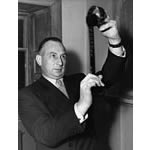






 |
|||||
 |
 |
 |
 |
 |
 |
|
Scottish Film Culture
Before 1938
The First Films of Scotland Committee Scottish Film Culture Between the Committees The Second Films of Scotland Committee Production Distribution & Exhibition
 Forsyth Hardy, who organised the Ministry of Information's Scottish Regional Office and chaired the second Films of Scotland Committee. |
Scottish Film Culture Between the CommitteesScottish film culture continued to develop. In 1939 the Scottish Film Council established the Scottish Film Library (later to become the SCFVL), a central library of educational films that testifies to the almost exclusively non-fictional nature of Scottish film production. In that same year, as Andrew Ferns (1985) has documented, the Ministry of Information, planned in 1935 and partially mobilised in 1938, became fully operational. While its headquarters were in London, Forsyth Hardy, later to chair the second Films of Scotland Committee, organised its Scottish Regional Office at the Scottish Office. In the first months of the war, in conjunction with the SFC and the SEFA, the office ran the Evacuation Film Scheme, using film library resources to maintain a number of travelling film units. Essentially an improvisation, throughout the winter of 1939-40 this scheme operated in the rural areas of Scotland, in the three months of its operation giving some 1500 shows to an audience of over 150,000. In September 1940 the Ministry of Information's Non-theatrical Film Scheme was formed. This served two functions; the organisation of special shows of films of a social, as distinct from an educational character; and the production of documentary films: "When started, the idea was to present shows of films depicting the war effort to voluntary organisations throughout the countryside, but this conception was soon found to be too narrow, and before long the idea of the film shows had changed. Significant war time audiences were found in the Canteen Audience of the factory, among Civil Defence workers and in the remote rural areas. [...] For all these audiences special techniques and special films were evolved: so that the units were not only showing films of war interest, but were also assisting in training these audiences in special skills essential to their war work or illustrating problems of a social character which were likely to be of significance to their lives." (Boyle, 1946, pp. 65-6) |
|
When the Films of Scotland Committee had been appointed it was with the understanding that, as a letter from the Thomas Johnston (1943, November 17) at the Scottish Office put it, 'if at any time it became impracticable to continue the production and circulation of Scottish films of national interest, the funds and the films held by the Committee should be at the disposal of the Secretary of State'. With the outbreak of war no new films were produced by the Committee, and its operations were held in suspense. Given that the Ministry of Information and the British Council were now producing films themselves, and that labour and materials were growing increasingly scarce, the Secretary of State for Scotland and the Scottish Development Council agreed in November 1943 'to terminate the existing arrangements and to make interim provision for the disposal of the funds and films' (Johnston, 1943). A small body of Trustees, subject to the directions of the Secretary of State was appointed and made responsible for this task. On behalf of the Trustees the Scottish Home Department placed the printing material for the original Films of Scotland productions in the care of the Government Cinematograph Adviser, who in turn placed them in the Central Office of Information. The immediate post-war years however saw Scottish film culture continue to flourish, with the arrival of the First Edinburgh International Film Festival in 1947 organised by the Film Guild and chaired by Norman Wilson. It also saw the end of any form of government financed filmmaking in 1952 (Hardy, 1990, p. 101). |
|


|
|
| Author: Richard Butt | Images are drawn from the SCRAN database. |